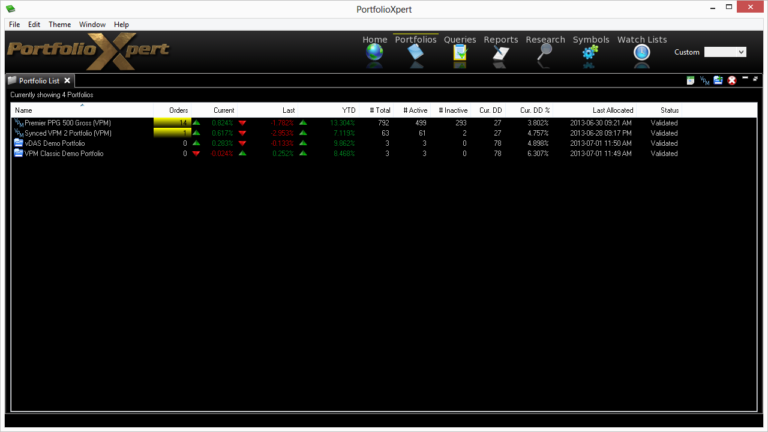General information
Software Introduction
VIEWS
VIEW BREAKDOWN
- Portfolio Rolling 12 Month Returns
- Portfolio Rolling 24 Month Returns
- Long Positions Breakdown Chart
- Active Symbols
- Current / Projected Positions
- Open Positions
- Portfolio List
- Monthly / Annual Returns
- Portfolio Orders
- Portfolio Symbol Returns
- Portfolio Trade Log
- Portfolio Trade Profile
- Combined Symbol Stats
- Fundamental Snapshot
- Quick Search
- Research
- Symbol History
- Symbol Model Results
- Symbol Stats History
- Symbol Trade Log
- Symbol Trade Profile
- Trend / Resistance / Support
- Queries
- Reports
- Watch List Triggers
- Watch Lists
PERSPECTIVES
PORTFOLIO
QUERY
WATCH LIST
Portfolio List
The Portfolio List view displays all user built portfolios (PortfolioXpert and VPM 2.0) and any subscribed Premier portfolios.

View Tab

- Double click the view tab to maximize the view full screen. Double click it again to restore.
- Right mouse click on the view tab to open the view popup menu.
- Click

- in the view tab to close the Portfolio List view.
- Left mouse click the view tab and hold down the mouse button to move the Portfolio List view. Release the mouse button to place it.
View Toolbar
The View Toolbar contains controls and settings specific to the Portfolio List view. Mouse hover over a button to see its tooltip.
Table to Spreadsheet button
- Click

- to export the Portfolio List table to a spreadsheet (sorting applied prior to exporting will be preserved in the spreadsheet).
Hide My VPM 2.0 Portfolios
- Click

- to toggle your synced VPM 2.0 portfolios between being visible and hidden. Click here for more information about VPM 2.0 portfolios in PortfolioXpert.
New Portfolio
- Click

- to build a new portfolio. Click here for detailed instructions on building a new VPM Classic portfolio, or click here for instructions on building a new vDAS portfolio.
Delete Portfolio(s)
- Click

- to delete a selected portfolio. Click here for detailed instructions on deleting a portfolio.
Information Displayed
- Name – portfolio name
- Orders – indicates whether or not a portfolio has any pending orders and displays the number of orders pending
- Current – current period’s performance information in percentage terms
- Daily Portfolios – performance information based on the close two business days prior to the current day and the previous business day’s close (i.e. on 07/01/13, closing prices on 06/27/13 determine the beginning values and closing prices on 06/28/13 determine the ending values)
- Weekly Portfolios – performance information based on the previous week’s ending values and the previous business day’s ending values (i.e. on 07/01/13, closing prices on 06/21/13 determine the beginning values and closing prices on 06/28/13 determine the ending values)
- Last – the previous period’s performance information in percentage terms
- Daily Portfolios – performance information based on the close three and two business days prior to the current day (i.e. on 07/01/13, closing prices on 06/26/13 determine the beginning values and closing prices on 06/27/13 determine the ending values)
- Weekly Portfolios – performance information based on the ending values two and one week prior to the current week (i.e. on 07/01/13, closing prices on 06/14/13 determine the beginning values and closing prices on 06/21/13 determine the ending values)
- YTD – year-to-date performance information based on the previous year’s ending values and the last business day’s ending values (i.e. on 07/01/13, closing prices on 12/31/12 determine the beginning values and closing prices on 06/28/13 determine the ending values)
- # Total – total number of securities in the portfolio (includes both active and inactive)
- # Active – number of securities in the portfolio that are currently being monitored
- # Inactive – number of securities in the portfolio that are NOT currently being monitored
- Cur. DD – number of market days from the portfolio’s last equity high date (if applicable)
- Cur DD % – percent decline from the portfolio’s last equity high (if applicable)
- Last Allocated – date corresponding to the last time the portfolio statistics were updated (typically the last business or trading day)
- Status – indicates the current status of the portfolio in the system (e.g. Validated, Invalidated, Queued For Allocation)